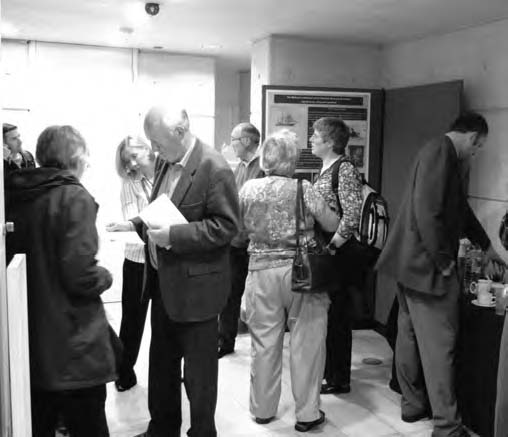|
This all-day meeting, held on 8th September 2007, was a new venture for the Conchological Society, as it was a joint meeting with the National Museums Scotland (NMS), who provided the premises and whose staff, in particular Claire Pannell, did a large amount of the organisation of the meeting. A number of speakers gave talks on the general theme of interactions between molluscs and humans, interpreted in its broadest sense. The meeting was held in the Dunfermline Room of the Museum, an intimate lecture theatre in the modern extension which not only stimulated a lot of discussion, but also had a suitable circulating space outside for refreshments, posters and demonstrations. The meeting was opened and chaired throughout by Julia Nunn (Conchological Society President), who introduced Claire Pannell (NMS) as the first speaker. She told us of the importance of the Museum collections for the purposes of scientific study, and showed us several examples from the collections, which are, of course available to bona fide investigators. Adrian Sumner (North Berwick) was the next speaker, who summarised the status of non-marine molluscs in Scotland, pointing out factors such as climate and lack of lime that restrict the number of species in Scotland. Nevertheless, many species are increasing their ranges in Scotland. Dan Harries and Colin Trigg (Heriot-Watt University, Edinburgh) concluded the morning session with a talk on “Scottish reef building molluscs”. Modiolus modiolus and Mytilus edulis both form dense beds on the sea floor, while Limaria hians builds nests by binding shell fragments and pebbles together with their byssal threads. The speakers discussed the biodiversity associated with these sites, and the risks to these structures from human activities. After an excellent buffet lunch, during which we were also able to examine the various exhibits which people had brought, the afternoon session was opened by Peter Cosgrove (Granton-on-Spey). Peter is an authority on the freshwater pearl mussel Margaritifera margaritifera, which he regards as one of the most charismatic animals in Scotland. After a long period of decline, brought on by pollution and particularly by pearl fishing (now illegal), it is felt that the situation may have been stabilised. Landowners are now very protective of “their” mussels, and programmes are now under way to restock suitable rivers from which pearl mussels have been lost. The next speaker, Gill Andrew of the Scottish Association for Marine Science at Dunstaffnage, near Oban, told us about her studies on the feeding habits of limpets, Patella vulgata. Biofilms have been regarded as the most important food source for limpets, but by using stable isotope tracers and examining gut contents, Gill has shown that seaweeds are an important component of their diet. Perhaps her most convincing evidence was a video of a limpet actually chewing Laminaria (http://www.youtube.com/watch?v=79RvGRUdnwE)! After a break for tea, Jessica Winder spoke about her studies on eating oysters in Britain. Over the centuries, people have used oysters as food to different extents, and it was interesting see how studies of discarded oyster shells in middens and elsewhere could yield so much information about our ancestors dietary habits. Of course, oysters are now regarded as a luxury food, but in the past they were often a cheap staple of people’s diet. Humans have not used molluscs simply as food, of course. From early prehistoric times shells have been used as ornaments, and Chantal Knowles (NMS) concluded the afternoon by describing some of the many ways in which they have been used, particularly in Oceania. Thus concluded a stimulating day in which we heard about the great variety of ways in which molluscs and people interact, and about ongoing research in the field. As well as thanking the speakers, we should also thank the audience, who contributed materially to the success of the meeting with their contributions during informal discussions. We hope to hold a similar meeting in the future. |
|
Man and Molluscs: Diversity and Commercial Uses of Molluscs
Issue
16
Page
25

 Man and Molluscs meeting: delegates in discussion during the refreshment break
Man and Molluscs meeting: delegates in discussion during the refreshment break